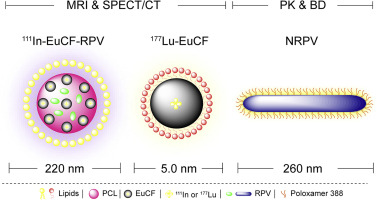Biomaterials ( IF 14.0 ) Pub Date : 2018-09-14 , DOI: 10.1016/j.biomaterials.2018.09.018 Brendan M. Ottemann , Austin J. Helmink , Wenting Zhang , Insiya Mukadam , Christopher Woldstad , James R. Hilaire , Yutong Liu , JoEllyn M. McMillan , Benson J. Edagwa , R. Lee Mosley , Jered C. Garrison , Bhavesh D. Kevadiya , Howard E. Gendelman

|
Antiretroviral therapy (ART) has changed the outcome of human immunodeficiency virus type one (HIV-1) infection from certain death to a life free of disease co-morbidities. However, infected people must remain on life-long daily antiretroviral therapy (ART). ART reduces but fails to eliminate the viral reservoir. In order to improve upon current treatment regimens our laboratory created long acting slow effective release (LASER) ART nanoformulated prodrugs from native medicines. LASER ART enables antiretroviral drugs (ARVs) to better reach target sites of HIV-1 infection while, at the same time, improve ART's half-life and potency. However, novel ARV design has been slowed by prolonged pharmacokinetic testing requirements. To such ends, a tri-modal theranostic nanoparticles were created with single-photon emission computed tomography (SPECT/CT) magnetic resonance imaging (MRI) and fluorescence capabilities to predict LASER ART biodistribution. The created theranostic ARV probes were then employed to monitor drug tissue distribution and potency. An Intrinsically radiolabeled “111Indium (111In)”, europium doped cobalt-ferrite particles were encased in a polycaprolactone core surrounded by a lipid shell containing rilpivirine (111InEuCF-RPV). Particle cell, tissue distribution and antiretroviral activities were sustained in macrophage depots within the reticuloendothelial system. 111InEuCF-PCL/RPV particles injected into mice demonstrated co-registration of MRI and SPECT/CT tissue signals with RPV and cobalt. Cell and animal particle biodistribution paralleled the antiretroviral activities of nanoformulated RPV. We posit that particle selection can predict ARV distribution and potency facilitated by multifunctional theranostic nanoparticles.
中文翻译:

瑞匹韦林生物分布和抗逆转录病毒活性的生物影像预测因子
抗逆转录病毒疗法(ART)已将人类免疫缺陷病毒1型(HIV-1)感染的结果从某些死亡改变为无疾病合并症的生活。但是,感染者必须继续终生每日抗逆转录病毒疗法(ART)。ART减少但不能消除病毒库。为了改善当前的治疗方案,我们的实验室从天然药物中制备了长效缓慢有效释放(LASER)ART纳米配方前药。激光ART使抗逆转录病毒药物(ARV)更好地到达HIV-1感染的目标部位,同时提高ART的半衰期和效力。但是,新的抗逆转录病毒药物的设计由于延长的药代动力学测试要求而减慢了速度。为此,利用单光子发射计算机断层扫描(SPECT / CT)磁共振成像(MRI)和荧光功能创建了三峰治疗疗法纳米粒子,以预测激光ART的生物分布。然后将所创建的治疗诊断型ARV探针用于监测药物组织的分布和效力。本质上带有放射性标记的“将111铟(111 In)”掺杂euro的钴铁氧体颗粒包裹在聚己内酯核中,该核被含有rilpivirine(111 InEuCF-RPV)的脂质壳包围。在网状内皮系统内的巨噬细胞贮库中维持颗粒细胞,组织分布和抗逆转录病毒活性。注入小鼠体内的111种InEuCF-PCL / RPV颗粒与RPV和钴共同显示了MRI和SPECT / CT组织信号的共配准。细胞和动物颗粒的生物分布与纳米级RPV的抗逆转录病毒活性平行。我们认为,颗粒选择可以预测多功能治疗药物纳米颗粒促进的ARV分布和效价。



























 京公网安备 11010802027423号
京公网安备 11010802027423号